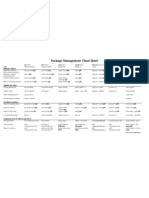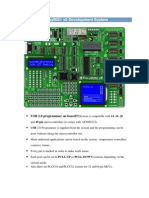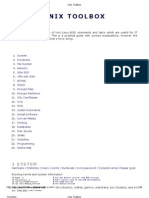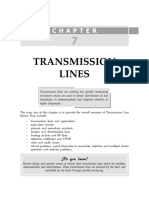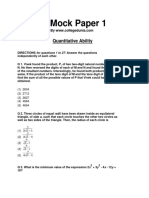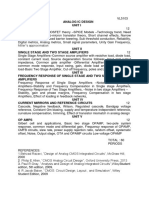Linux Command Cheat Sheet: Most Used Linux Commands Linux File Commands
Uploaded by
Edmar SouzaLinux Command Cheat Sheet: Most Used Linux Commands Linux File Commands
Uploaded by
Edmar SouzaLINUX COMMAND CHEAT SHEET
MOST USED LINUX COMMANDS LINUX FILE COMMANDS
pwd Displays the current working directory rm -r [directory_name] Remove a directory and files
path, starting from the root (/) recursively
cp -r [directory_name1] Used to copy a directory including
rm [file_name] To remove files you no longer need [directory_name2] all its content from a source
directory to the destination
directory.
Shows a file's contents one screen
less [filename] at a time Move file_name1 to file_name2
mv [file_name1] [file_name2]
Is used to change the current working
cd [directory] directory in Linux tail [file_name] Prints the last 10 lines from the file
ls To list files or directories in Linux Used to enlist the current directory
ls -a
including the hidden files
grep [PATTERN] [FILE] Used to search for a string of
characters in a specified file
cp [file_name1] [file_name2] Used to copy files or group of files
Used to enlist the current directory or directory
ls-a
including the hidden files
rm [file_name] Deletes a file
cp [file] [destination] Copying files from one location to
another pwd Displays the current working
directory path, starting from the
mv [file] [destination] Used to move files and directories root (/)
from one location to another
rmdir It removes an empty directory on
various operating systems
mkdir [directory] Allows users to create or make new
directories
mkdir [directory] Allows users to create or make new
directories
curl [options] [URL] A tool that enables data transfer
over various network protocols.
LINUX DIRECTORY NAVIGATION Supported protocols (HTTP,
HTTPS, SCP, SFTP, FTP)
cd - Controls to the previous directory level
diff [file_name_1] Is used to display the differences in
[file_name_2] the files by comparing the files line
Used to change directory to the home by line
cd or cd ~
directory
tar Used to compress a group of files
cd / Used to change directory to the root into an archive
directory
locate [file_name] Finds files in Linux using the file
cd... Used to move to the parent directory name
of current directory
cat [file1] [file2] It reads data from the file and
gives their content as output
cd Go directly to directory
[/path/to/directory] tar -cf Creates or extracts archived files
wget [URL] Used to download files from
the internet.
echo [text]>>[file_name] Used to display line of text/string
that are passed as an argument
mv [file name Used to move files and directories
/path/to/new/location from one location to another
tar -xvf [file_name] Used to compress a group of files
into an archive
-x includes the eXtended attributes
of the files (metadata)
-v is verbose mode
-f tells tar what file/archive you are
unarchiving
gpg [file_name.gpg] Encrypts the files securely
LINUX COMMAND CHEAT SHEET
LINUX SSH (LOGIN) LINUX FILE COMMANDS
ssh -i ~/.ssh/specific_ssh_fkey Distinguished other ssh key for ln -s
Creates a symbolic link to a file
connection /path/to/[file_name] [link_name]
ssh user@server -p other_port Operate a specific port declared touch [file_name] Used to create, change and
in sshd_config modify timestamps of a file
ssh [IP address] Connect to a host wc Used to find out number of lines,
word count, byte and characters
count in the files
ssh-copy-id hostname_or_IP Copy a unique key pair to server
gpg -c [file_name] Decrypts the files securely
ssh user@server Connect to a server (default port)
head [file_name] Allows you to easily get the top
lines from the specified file or the
ssh user@server [command to run] Run a command on a remote server standard input
ls To list files or directories in Linux
LINUX NETWORK DIAGNOSTICS COMMANDS
ifup [options] -a [device] Used to activate the specified
network interface
LINUX PIPES/REDIRECTION
hostname Used to obtain the DNS name and set
the system's hostname or NIS domain << Launch a file and and captures
name user input until EOF
traceroute [host] Perform traceroute to [host] > Represents output redirection
and redirects output to a file and
overwriting the file
ifdown [options] -a|[device] Disables a network interface
ex. A Linux pipe is a form of
hostname -l (capital ‘i’) Shows all IP addresses of computer command_1 | command_2 redirection used to combine two
| command_3 or more commands where the
output of one command acts as
netstat Displays information about different the input of the next command in
interface statistics,including open the sequence.
sockets, routing tables, and
connection information
>> Redirects output to a file and
appends the redirected
ifconfig/ip Used to configure, control the output rather than overwrites
queries from CLI and to enable or
disable the IP address, view all
network interfaces. Also to set up < Represents input redirection and
any/all the network interfaces such as redirects the given input file
Ethernet, wireless, modem and so on
that are connected to your computer
dig [record type] [domain] Gather information about a particular
domain. Try “dig txt google.com”
nettop Monitor network activity, showing a
list of processes and corresponding
process IDs with network
connections
ping [address] Send ICMP ECHO_REQUEST packets
to network host at [address]
nslookup [address] Use the IP address to discover a
domain name, or vice versa.
LINUX COMMAND CHEAT SHEET
USER CONTROLS AND MANAGEMENT USER WARNING: SOME OF
SYSTEM INFORMATION
THESE COMMANDS CAN BE DANGEROUS. USE WITH CAUTION.
cat /proc/cpuinfo Display detailed information about (sudo) service ssh stop Stop ssh service
the CPU
(sudo) service ssh start Start ssh service
pstree Display a tree of running processes
(sudo) service ssh restart Restart ssh service
du Return disk usage
(sudo) service ssh status Check ssh service status
df –m Display free storage in megabytes
sudo passwd root Set a new password for the
du –h [directory Return disk usage in a readable file root user, can be used to
size format Eg. 1.1K or 15M 1.5G circumvent the sudo
(-m shows file in megabytes and command
-g shows a file in gigabytes)
passwd Change your password
lshw | less List all hardware and pipes to the
less command for easy reading and
pagination useradd [user_name] Create a new user
swapon -s Swap information useradd –r [user_name] Delete a user
lsusb (or -v for verbose) Show information about all usb finger [username] Display information about a
devices. user
pmap –x PID [pid] Display memory information about a
chmod [permission] [file_name] Change the permissions of
process
a file
Eg. chmod 777 /path/to/file
lspci (or -v for verbose) Show information about all PCI
Display sorted information about groups [username] Display the groups a user
top belongs to
processes
sudo systemctl restart Restart a service chown user:group /path/to/file Change ownership of a file
[service_name] Eg. sudo systemctl restart apache2
chown –R user:group /path/to Change the ownership of
dmidecode | less Summarize BIOS information /directory a directory and files
chroot [path] [command] Change the root directory
kill [pid] Terminate a process. Use the ‘top’ of a process
command to find the pid of a
process
quit Logout
cat /etc/issue The cat command shows
information about a given directory w Display currently logged
, in this cat /ect/issue. in users
free Free shows system information
such as free memory and swap in
kibibytes
LINUX COMMAND CHEAT SHEET
OTHER
alias [new command name] Create a temporary alias for
=[command] a command
date Display current system date and
time
env Display environment variables
[tab] Autocomplete command you are
typing, if autocomplete has been
configured for your shell session.
history Display prior used commands
shutdown Turns a computer off
shutdown –r Reboots a computer
at [-V] [-q queue] [-f file] Run a command at a specific time
[-mldbv] TIME
iostat List CPU and I/O statistics
clear Clear all information from the
terminal window. Not useful for
security.
crontab –e Create a new crontab or edit an
existing crontab
man [command name] Display the manual or help file for a
command
unset [variable_name] Remove environment variable
export [variable_name]
Create a new environment variable
=[variable_value]
100% Linux Hands-on Exercise on Linuxpath.org
These Linux exercises from Linuxpath.org will help you learn everything about Linux from the boot process to advanced networking
You might also like
- Configuration of a Simple Samba File Server, Quota and Schedule BackupFrom EverandConfiguration of a Simple Samba File Server, Quota and Schedule BackupNo ratings yet
- DRBD-Cookbook: How to create your own cluster solution, without SAN or NAS!From EverandDRBD-Cookbook: How to create your own cluster solution, without SAN or NAS!No ratings yet
- Red Hat Enterprise Linux 6 Administration: Real World Skills for Red Hat AdministratorsFrom EverandRed Hat Enterprise Linux 6 Administration: Real World Skills for Red Hat AdministratorsNo ratings yet
- Linux Setup SSH - Linux Tutorials - Learn Linux ConfigurationNo ratings yetLinux Setup SSH - Linux Tutorials - Learn Linux Configuration11 pages
- SysInternals Pro - Using PsTools To Control Other PCs From The Command LineNo ratings yetSysInternals Pro - Using PsTools To Control Other PCs From The Command Line10 pages
- Systemd On Linux - Manage Services, Run Levels and Logs100% (1)Systemd On Linux - Manage Services, Run Levels and Logs8 pages
- 15 Command Line Tools To Monitor Linux Performance PDF100% (1)15 Command Line Tools To Monitor Linux Performance PDF25 pages
- How To Fix A Broken Initrd Image in Linux-1No ratings yetHow To Fix A Broken Initrd Image in Linux-17 pages
- Linux Kernel Programming: A comprehensive and practical guide to kernel internals, writing modules, and kernel synchronizationFrom EverandLinux Kernel Programming: A comprehensive and practical guide to kernel internals, writing modules, and kernel synchronizationNo ratings yet
- Find The Answers To These Questions in The Followingtext.: Specialist ReadingNo ratings yetFind The Answers To These Questions in The Followingtext.: Specialist Reading3 pages
- 7.1 Control Access To Files With Linux File System PermissionsNo ratings yet7.1 Control Access To Files With Linux File System Permissions7 pages
- 25 Useful Basic Commands of APT-GET and APT-CACHE For Package ManagementNo ratings yet25 Useful Basic Commands of APT-GET and APT-CACHE For Package Management13 pages
- CHAPTER 1 Installing Red Hat Enterprise Linux Server: 1. Basic Shell SkillsNo ratings yetCHAPTER 1 Installing Red Hat Enterprise Linux Server: 1. Basic Shell Skills7 pages
- (Kali - Training) Managing Users and GroupsNo ratings yet(Kali - Training) Managing Users and Groups6 pages
- Embedded Linux System Development Training Lab BookNo ratings yetEmbedded Linux System Development Training Lab Book4 pages
- Attacking WiFi With Traffic Injection Cedric BlancherNo ratings yetAttacking WiFi With Traffic Injection Cedric Blancher70 pages
- Q.1a What Are Different Linux Distribution? Explain Each in BriefNo ratings yetQ.1a What Are Different Linux Distribution? Explain Each in Brief5 pages
- Setup L2TP - IPsec VPN Server On SoftEther VPN Server - SoftEther VPN ProjectNo ratings yetSetup L2TP - IPsec VPN Server On SoftEther VPN Server - SoftEther VPN Project4 pages
- LS, LL, W, Whoami, CD, PWD, Mkdir, MV, Rmdir, CP: Lab Session (6) : Networking100% (1)LS, LL, W, Whoami, CD, PWD, Mkdir, MV, Rmdir, CP: Lab Session (6) : Networking7 pages
- Securing Linux by Hardening The Grub Boot Loader100% (32)Securing Linux by Hardening The Grub Boot Loader17 pages
- RHCSA Exam Pass: Red Hat Certified System Administrator Study GuideFrom EverandRHCSA Exam Pass: Red Hat Certified System Administrator Study GuideNo ratings yet
- Performance Enhancement of Low Pressure Turbine Cascade by Introducing Tubercles100% (1)Performance Enhancement of Low Pressure Turbine Cascade by Introducing Tubercles7 pages
- A Novel Thermal Model For HEVEV Battery Modeling Based On CFDNo ratings yetA Novel Thermal Model For HEVEV Battery Modeling Based On CFD8 pages
- Dynamic Memory Allocation in C Using MallocNo ratings yetDynamic Memory Allocation in C Using Malloc3 pages
- Quantum Field Theory A Diagrammatic Approach 1st Edition Ronald Kleiss pdf download100% (1)Quantum Field Theory A Diagrammatic Approach 1st Edition Ronald Kleiss pdf download34 pages
- Deep Learning in C# - Understanding Neural Network Architecture - CodeProjectNo ratings yetDeep Learning in C# - Understanding Neural Network Architecture - CodeProject4 pages
- Metal Matrix Composites For Aerospace Application: Advanced Materials100% (1)Metal Matrix Composites For Aerospace Application: Advanced Materials3 pages
- WD Elements Portable SE Specifications (English)No ratings yetWD Elements Portable SE Specifications (English)2 pages
- Solcon USA HRVS DN MV 10 13pt8kV Spec Guide 2011100% (1)Solcon USA HRVS DN MV 10 13pt8kV Spec Guide 201110 pages
- Direct Compression - An Overview: - ReviewNo ratings yetDirect Compression - An Overview: - Review4 pages
- Configuration of a Simple Samba File Server, Quota and Schedule BackupFrom EverandConfiguration of a Simple Samba File Server, Quota and Schedule Backup
- DRBD-Cookbook: How to create your own cluster solution, without SAN or NAS!From EverandDRBD-Cookbook: How to create your own cluster solution, without SAN or NAS!
- Red Hat Enterprise Linux 6 Administration: Real World Skills for Red Hat AdministratorsFrom EverandRed Hat Enterprise Linux 6 Administration: Real World Skills for Red Hat Administrators
- Linux Setup SSH - Linux Tutorials - Learn Linux ConfigurationLinux Setup SSH - Linux Tutorials - Learn Linux Configuration
- SysInternals Pro - Using PsTools To Control Other PCs From The Command LineSysInternals Pro - Using PsTools To Control Other PCs From The Command Line
- Systemd On Linux - Manage Services, Run Levels and LogsSystemd On Linux - Manage Services, Run Levels and Logs
- 15 Command Line Tools To Monitor Linux Performance PDF15 Command Line Tools To Monitor Linux Performance PDF
- Linux Kernel Programming: A comprehensive and practical guide to kernel internals, writing modules, and kernel synchronizationFrom EverandLinux Kernel Programming: A comprehensive and practical guide to kernel internals, writing modules, and kernel synchronization
- Find The Answers To These Questions in The Followingtext.: Specialist ReadingFind The Answers To These Questions in The Followingtext.: Specialist Reading
- 7.1 Control Access To Files With Linux File System Permissions7.1 Control Access To Files With Linux File System Permissions
- 25 Useful Basic Commands of APT-GET and APT-CACHE For Package Management25 Useful Basic Commands of APT-GET and APT-CACHE For Package Management
- CHAPTER 1 Installing Red Hat Enterprise Linux Server: 1. Basic Shell SkillsCHAPTER 1 Installing Red Hat Enterprise Linux Server: 1. Basic Shell Skills
- Embedded Linux System Development Training Lab BookEmbedded Linux System Development Training Lab Book
- Attacking WiFi With Traffic Injection Cedric BlancherAttacking WiFi With Traffic Injection Cedric Blancher
- Q.1a What Are Different Linux Distribution? Explain Each in BriefQ.1a What Are Different Linux Distribution? Explain Each in Brief
- Setup L2TP - IPsec VPN Server On SoftEther VPN Server - SoftEther VPN ProjectSetup L2TP - IPsec VPN Server On SoftEther VPN Server - SoftEther VPN Project
- LS, LL, W, Whoami, CD, PWD, Mkdir, MV, Rmdir, CP: Lab Session (6) : NetworkingLS, LL, W, Whoami, CD, PWD, Mkdir, MV, Rmdir, CP: Lab Session (6) : Networking
- RHCSA Exam Pass: Red Hat Certified System Administrator Study GuideFrom EverandRHCSA Exam Pass: Red Hat Certified System Administrator Study Guide
- Performance Enhancement of Low Pressure Turbine Cascade by Introducing TuberclesPerformance Enhancement of Low Pressure Turbine Cascade by Introducing Tubercles
- A Novel Thermal Model For HEVEV Battery Modeling Based On CFDA Novel Thermal Model For HEVEV Battery Modeling Based On CFD
- Quantum Field Theory A Diagrammatic Approach 1st Edition Ronald Kleiss pdf downloadQuantum Field Theory A Diagrammatic Approach 1st Edition Ronald Kleiss pdf download
- Deep Learning in C# - Understanding Neural Network Architecture - CodeProjectDeep Learning in C# - Understanding Neural Network Architecture - CodeProject
- Metal Matrix Composites For Aerospace Application: Advanced MaterialsMetal Matrix Composites For Aerospace Application: Advanced Materials
